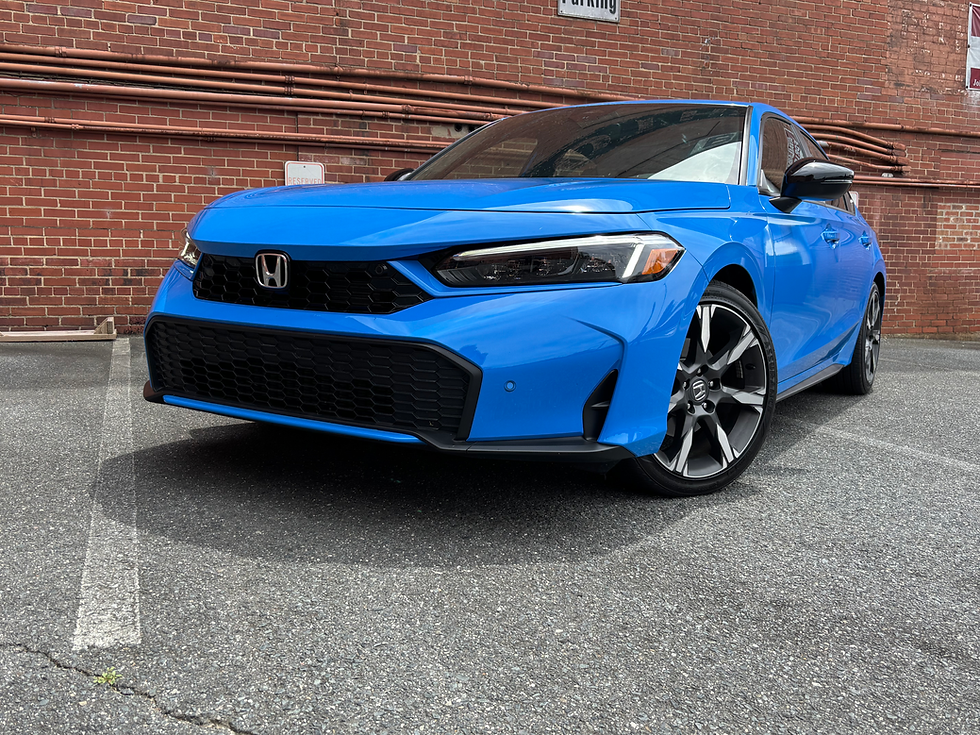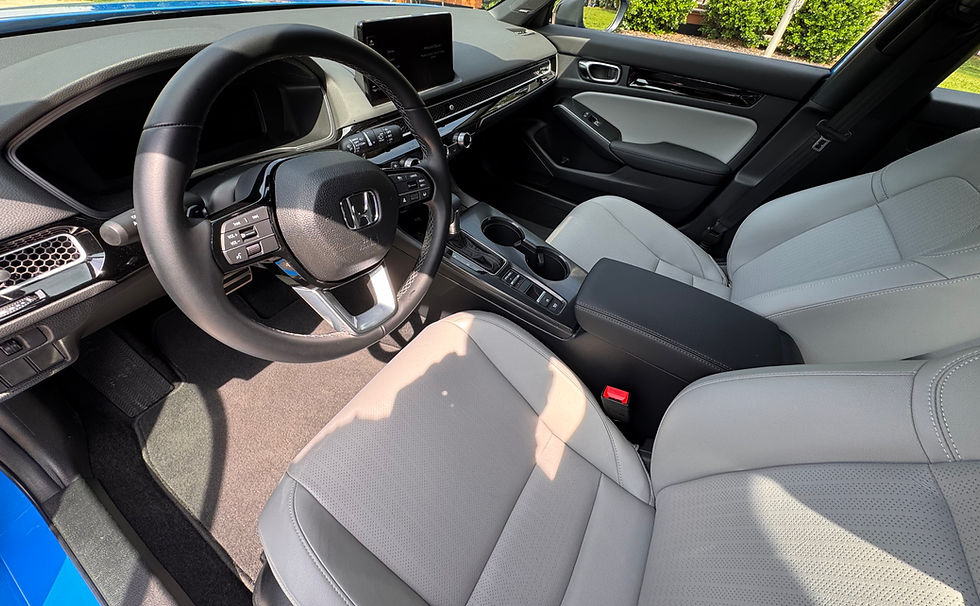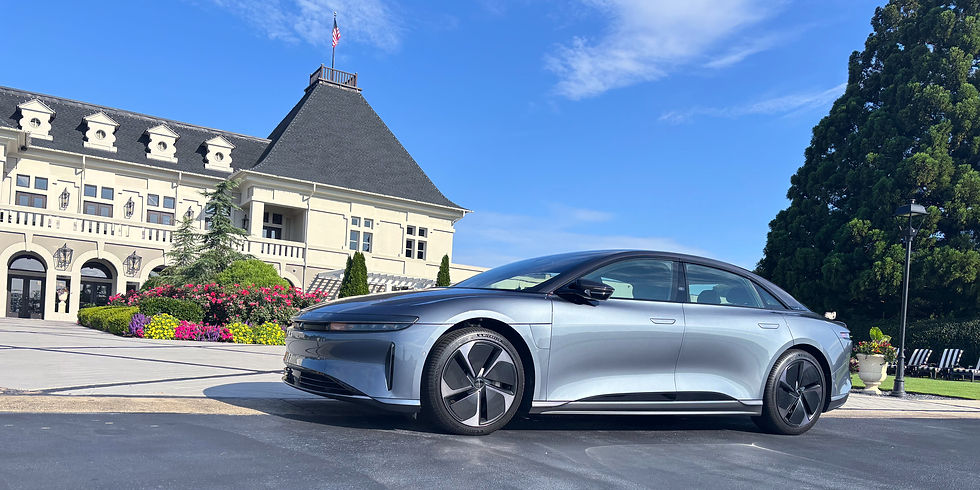Reviewed: The 2025 Honda Civic Sport Touring Hybrid Hatchback – There’s a New Si in Town.
- The Driver's Line

- Jun 10
- 6 min read

by Greg Karpinski
Do you remember the Honda Insight? The original was a quirky two-door liftback that debuted in the year 2000 and met with tepid sales, which was then replaced with mild bathwater for the second generation, arriving on US shores a decade later in 2010. Automotive scribe Jeremy Clarkson hailed it as “biblically terrible” and, for once, he was right. A rather handsome third and final generation arrived in 2019 and limped along until 2022 when Honda finally decided to put it out of its misery. You’d be forgiven if you don’t remember the Insight, and frankly, Honda would probably prefer it that way.
The idea behind the Insight wasn’t a bad one, it was simply the execution. The first-generation Insight we can chalk up to being interesting and unique. Honda was trying something new and it was quirky – at the time, it was the most aerodynamic production car in the world with a drag coefficient of 0.25. The problems arose in the second and third generations – Honda saw the success of the Toyota Prius and decided to try and out-Toyota Toyota, failing rather spectacularly.
With the Insight, Honda had forgotten who it was and what makes their cars special, which brings us to the 2025 Civic Sport Touring Hybrid Hatchback. It’s an absolute masterpiece.
The Fine Print: Honda wanted us to try out the 2025 Honda Civic Sport Touring Hybrid Hatchback so badly that they dropped it off with a full tank of gas and let us keep it a week, and didn’t even get mad when Jordan used it to haul around 20 bags of mulch.

The facelifted 2025 Civic reinforces the fact that Honda realizes that their consumer base still wants the high-quality, engaging, innovative and fun-to-drive cars they became known for in the 1980s and 1990s and, outside of the fire-breathing Civic Type R, this Civic Sport Touring Hybrid Hatchback is the top of the model’s range. The exterior revisions for 2025 are somewhat minimal but result in a cohesive design that is reminiscent of what a modernized version of the excellent fourth generation Accord might look like today. A revised nose, borrowed from the Civic Si, improves the grill and better aligns it with the LED headlights. Matte black trim on the lower front fascia and side skirts act as a nice contrast to our tester’s $455 optional Boost Blue Pearl color, which, at first glance, looks solid but has a subtle pearlescent metallic flake when light hits it and simply looks fabulous. The 18” wheels on the Sport Touring trim wear meaty 235 section width rubber and sport Matte Shark Grey inserts, adding depth and contrast against the polished aluminum finish.
With the slinky hatchback body, black side mirrors and blacked out window trim reducing the visual height, this car looks exceptional and is undeniably best in class. When my biggest gripe is that Honda refuses to use LED indicators in their LED head- and taillight housings, you know there isn’t much to complain about. Also, given how the awesome the Type R looks with that rear wing finishing off the design of the hatchback, a smaller, more subtle version wouldn’t be out of place here. We could even call it the Sport Touring Sport Hybrid Sport Hatchback, now with even more Sport!

Inside, not much has changed for the top dog Sport Touring Hybrid trim for 2025 and it continues to come very well-equipped as standard. You get a choice of black or grey leather seating and, unless you adore a sea of black inside your cars, the grey leather our tester had is absolutely the way to go. It breaks up a dark cabin into a much more welcoming place to be, as Honda also puts splashes of the color on the door cards. At nearly 100 cubic feet of passenger volume the grey leather interior, coupled with large windows, makes the cabin feel open and airy. Honda also packs in just about every available feature you’d expect to find in a car above this class – in addition to the leather seats, you’ll find a sunroof, dual zone automatic climate control, heated front seats, a full suite of Honda Sensing safety features like lane-keep assist and adaptive cruise, USB-C ports up front and a 12-speaker Bose audio system with wireless CarPlay and Android Auto. On the technology front, this Civic has a 10.2” configurable digital gauge cluster and a 9” infotainment screen with sharp graphics and, in the true spirit of Honda, both are intuitive and easy to use.
One of the best features of this Civic is simply the fact that it’s a hatchback. Despite an overall length more than five inches shorter than the Civic sedan, the hatchback can swallow 24.5 cubic feet of stuff with the seats up, which nearly doubles to 46.2 cubic feet with the seats down. As our resident hatchback aficionado, Jordan took the Civic to Home Depot where it swallowed up 20 bags of mulch with ease. Take that, CUVs. Honda has also engineered a clever cargo cover that never needs to be removed – half of it retracts to the side of the vehicle and the other half remains fixed, keeping your belongings safe and out of sight.

While the interior is largely fantastic, it’s not all sunshine and rainbows. The knobs for the climate control look great but feel rather light and flimsy in your hands. Rear seat passengers don’t have their own air vents or USB-C chargers, so expect them to pass a long cord to you up front if they need to charge their phone. Heated seats aren’t available for rear passengers as well, so expect some complaining from the back seat until the car warms up on a cold winter’s morn, though the standard remote start will help you there.
Undeniably, the party piece of the car is its hybrid system – Honda has engineered a somewhat unique system which pairs a 141hp 2.0L Atkinson cycle four-cylinder with a 181hp electric motor that generates a combined output of 200hp and 232lbft. This output far exceeds the base Civic Sport’s 150hp and matches the Civic Si, but throws in an extra 40lbft for good measure, making this the most powerful Civic without the Type R badge, ever. Putting that power to the front wheels is what Honda terms an “eCVT” but it’s not actually a transmission. Instead, think of it as a direct-drive where the internal combustion engine can be clutched in for additional output under hard acceleration and to maximize efficiency at high-speed cruising. This all results in the Civic Sport Touring Hybrid Hatchback producing a 0-60 time of 6.3 seconds and eclipsing the quarter mile in 15.1 seconds at 90mph. Not that we’re keeping track, but that’s about five tenths quicker than the Civic Si to sixty.
Perhaps the most unique feature of these hybrid Civics is how Honda engineered them to feel familiar for buyers who have never owned a hybrid or EV. Honda’s hybrid system uses a small 1.1kwh lithium-ion battery pack and, considering the 181hp electric motor is the primary form of locomotion, that will deplete in a hurry. The 2.0L Atkinson cycle four-cylinder acts primarily as a generator, feeding power to that little battery pack, which is continuously depleted and restored as you drive the Civic around. The really cool part is that Honda, in their genius, have programmed the “eCVT” to simulate shifting through gears and the gasoline engine follows suit, adjusting its revs to match the simulated shifting as you accelerate and while it charges the battery. This symphony results in something that feels like a traditional internal combustion engine with brisk acceleration and the added benefit of approximately 595 miles of range, courtesy of some pretty exceptional gas mileage: EPA rated at 50mpg city, 45mpg highway and 48mpg combined.
The small battery, electric motor and all the trappings necessary to make it work do add a bit of weight – approximately 300lbs over the Civic Si for a curb weight of 3252lbs, according to Honda. What’s impressive is that you don’t really feel this additional heft when driving the car normally – it cruises happily along in a quiet and composed manner, with a taut, yet well-damped suspension and quick and nicely-weighted steering. Honda retuned the suspension, lowered it nearly half an inch and combined with a slightly lower center of gravity thanks to the heavy battery, gives it a rather impressive change of direction. Only when you begin to push it, you begin to feel a bit of the extra heft and pronounced understeer at the limit. You won’t mistake it for a hot hatch out on the Cherohala Skyway, but it certainly won’t put you to sleep.

All this goodness comes at a cost and, at first, it might shock you a bit. Our tester, finished in the optional Boost Blue Pearl, rings the register at $34,755 with destination and handling, or about ten grand more than the base Civic sedan. Ouch. Thinking logically about it, that’s not as bad as the knee jerk response – you get a handsome car full of features and technology, that accelerates quicker than the Civic Si and handles nearly as well, but with utility rivaling a crossover and can still achieve 50mpg for about $15,000 less than the price of an average new car? That’s seriously compelling.
So compelling, in fact, that we think it’s not only the best in its class, but it just may be a better Civic Si than the Civic Si.



Коментари